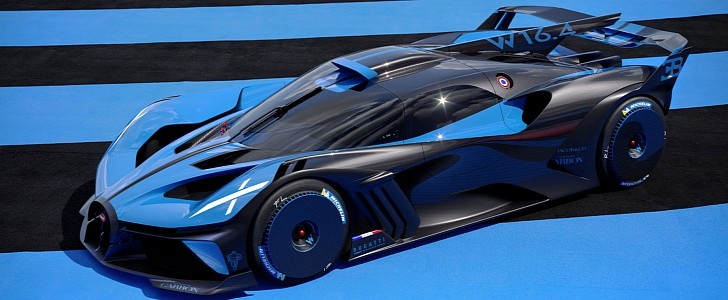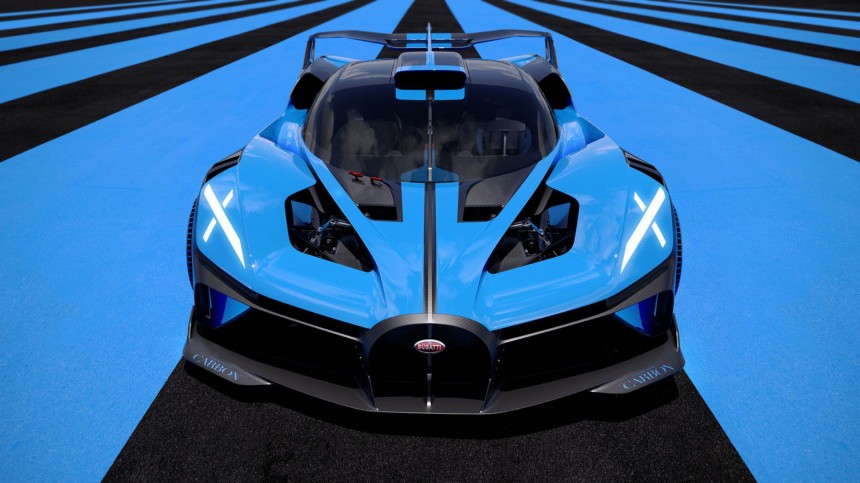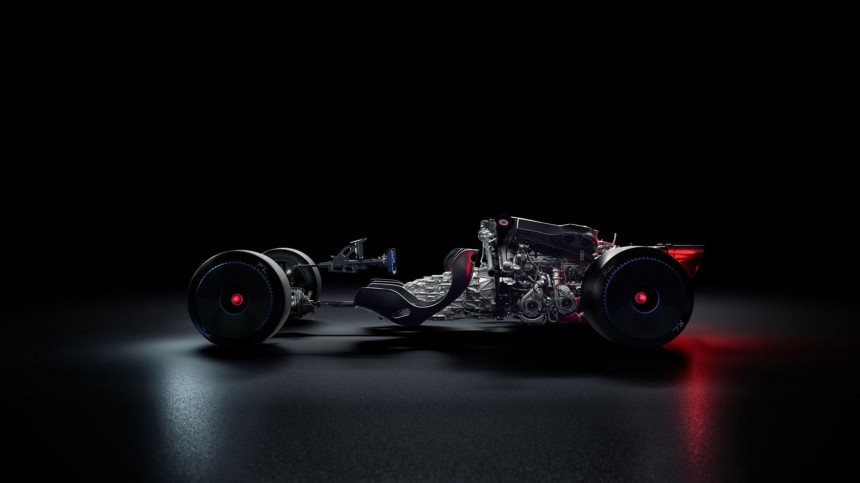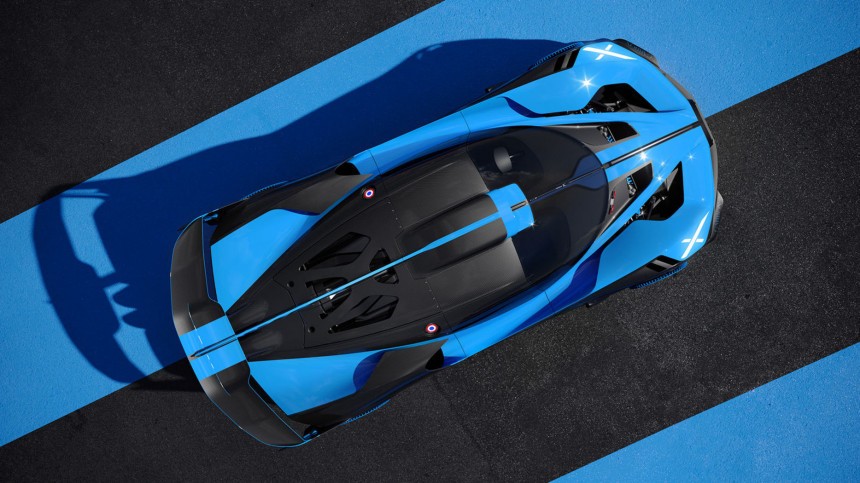“What if Bugatti built a radically light vehicle around its iconic 8.0-liter W16 engine?” This is a question that was on every car fanatic’s mind since the Veyron was released, fifteen years ago.
Well, we finally got the answer, with the French manufacturer revealing its latest hypercar concept, although the term ‘hypercar’ does not do it justice as it looks more like a Le Mans race car prototype.
Performance is at the same racecar level, as Bugatti claims that the innovative Bolide - which means race car in French – can take 3:07.1 minutes to complete a lap of the legendary Le Mans race track and 5:23.1 minutes to get around the equality famous and far more dangerous Nordschleife.
With the engineers obsessed to develop the lightest possible body in order get the most power out of the Chiron powertrain, the only luxuries left inside the car are a steering wheel and two seats which, you guessed it, are not the same as the ones we find in the Chiron, being replaced by lightweight racing versions.
They built the lightest possible chassis around the legendary powertrain, which consists of a carbon-fiber monocoque that complies with the latest FIA safety regulations.
The tensile strength of the fibers used in its construction is only achieved in the aerospace industry. The integral front end attached to it is also made of the same high-strength carbon fibers while the rear frame, which is designed as a welded assembly, is made of high-strength stainless steel, another material borrowed from the aviation industry.
All the screws and fastening elements are made of titanium and a 3D printer was used to make hollow thin-walled functional components. As a result of this, the dry weight of the Bolide stands at 1,240 kg (2734 lbs.).
At the center of this amazing car, we find the mighty 8.0-liter W16 engine, a technical symbol of Bugatti’s renaissance. It uses the same forged aluminum alloy cylinder block with plasma-coated cylinder bores as the “standard” W16 we can find on the Chiron.
Also, the cylinder heads and valvetrain are made of cast aluminum alloy and feature four valves per cylinder for a total of 64 valves.
To withstand the immense centrifugal forces and maintain optimal lubrication, the oil circuit, check valves, baffles, oil tanks, oil reservoirs, and pump design of the dry-sump lubrication have been upgraded.
The intake and exhaust system where dethrottled, and the four turbochargers where fitted with enhanced blades to generate more boost pressure and power at higher engine speeds.
Instead of the standard water-to-air intercooling, the new Bugatti uses air-to-air intercooling with water pre-cooling, which significantly reduces weight.
The two water coolers are mounted along the front axle and provide better airflow than a similar Formula 1 system. Three air-cooled oil coolers are used for the engine transmission and differential which are aided by the water-pre-cooling system.
The enhanced W16 on the Bolide can produce 1825 hp (136 1 kW; 1,850 PS) and 1,850 Nm (1364 lb.-ft) of torque which is more than the SSC Tuatara who has recently crowned the fastest production car in the world.
Although Bugatti only tells us that “top speed is well above 500 kph (310 mph)," without revealing the exact digits, we can expect them to make a run for the Tuatara’s record.
Due to its light construction and extreme power, it achieves an incredible power to weight ratio of 0.67 kilograms per horsepower.
The Bolide is the Bugatti we were all waiting for, a symbol of power stripped down to its purest form. We can only wait and see if the French carmaker decides to turn it into a limited-production series or if it was just a one-off experiment.
Performance is at the same racecar level, as Bugatti claims that the innovative Bolide - which means race car in French – can take 3:07.1 minutes to complete a lap of the legendary Le Mans race track and 5:23.1 minutes to get around the equality famous and far more dangerous Nordschleife.
With the engineers obsessed to develop the lightest possible body in order get the most power out of the Chiron powertrain, the only luxuries left inside the car are a steering wheel and two seats which, you guessed it, are not the same as the ones we find in the Chiron, being replaced by lightweight racing versions.
The tensile strength of the fibers used in its construction is only achieved in the aerospace industry. The integral front end attached to it is also made of the same high-strength carbon fibers while the rear frame, which is designed as a welded assembly, is made of high-strength stainless steel, another material borrowed from the aviation industry.
All the screws and fastening elements are made of titanium and a 3D printer was used to make hollow thin-walled functional components. As a result of this, the dry weight of the Bolide stands at 1,240 kg (2734 lbs.).
Also, the cylinder heads and valvetrain are made of cast aluminum alloy and feature four valves per cylinder for a total of 64 valves.
To withstand the immense centrifugal forces and maintain optimal lubrication, the oil circuit, check valves, baffles, oil tanks, oil reservoirs, and pump design of the dry-sump lubrication have been upgraded.
The intake and exhaust system where dethrottled, and the four turbochargers where fitted with enhanced blades to generate more boost pressure and power at higher engine speeds.
Instead of the standard water-to-air intercooling, the new Bugatti uses air-to-air intercooling with water pre-cooling, which significantly reduces weight.
The enhanced W16 on the Bolide can produce 1825 hp (136 1 kW; 1,850 PS) and 1,850 Nm (1364 lb.-ft) of torque which is more than the SSC Tuatara who has recently crowned the fastest production car in the world.
Although Bugatti only tells us that “top speed is well above 500 kph (310 mph)," without revealing the exact digits, we can expect them to make a run for the Tuatara’s record.
Due to its light construction and extreme power, it achieves an incredible power to weight ratio of 0.67 kilograms per horsepower.
The Bolide is the Bugatti we were all waiting for, a symbol of power stripped down to its purest form. We can only wait and see if the French carmaker decides to turn it into a limited-production series or if it was just a one-off experiment.













